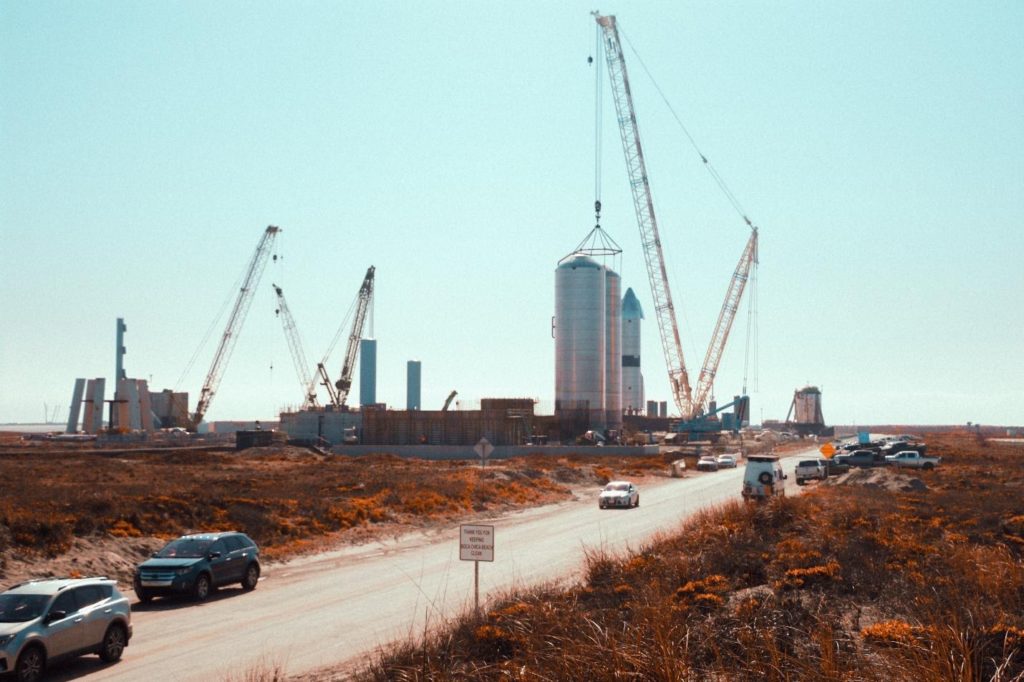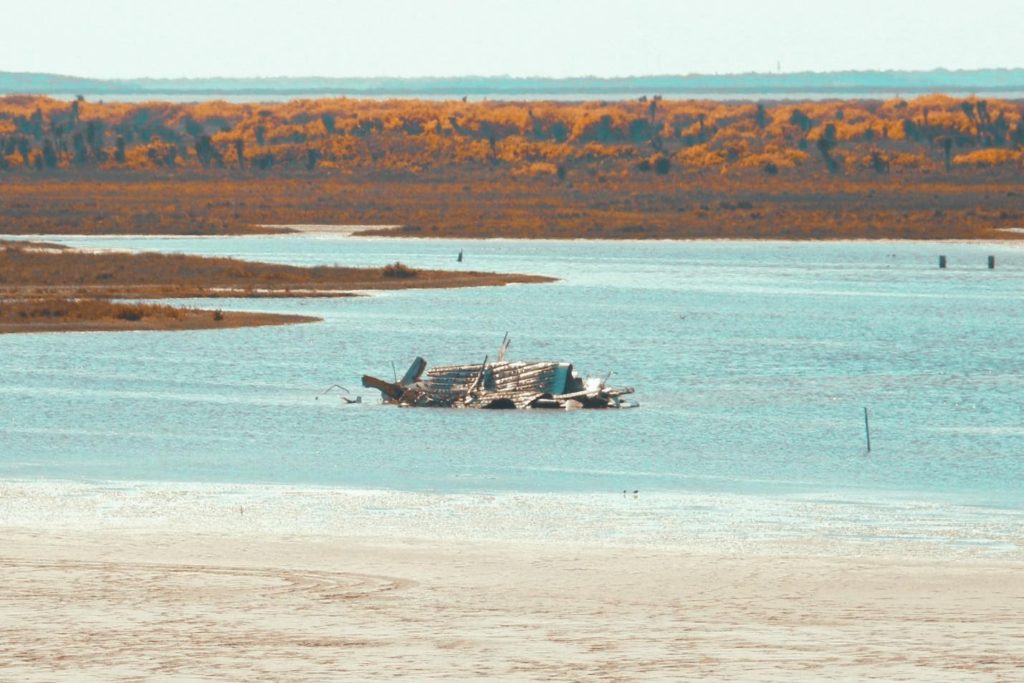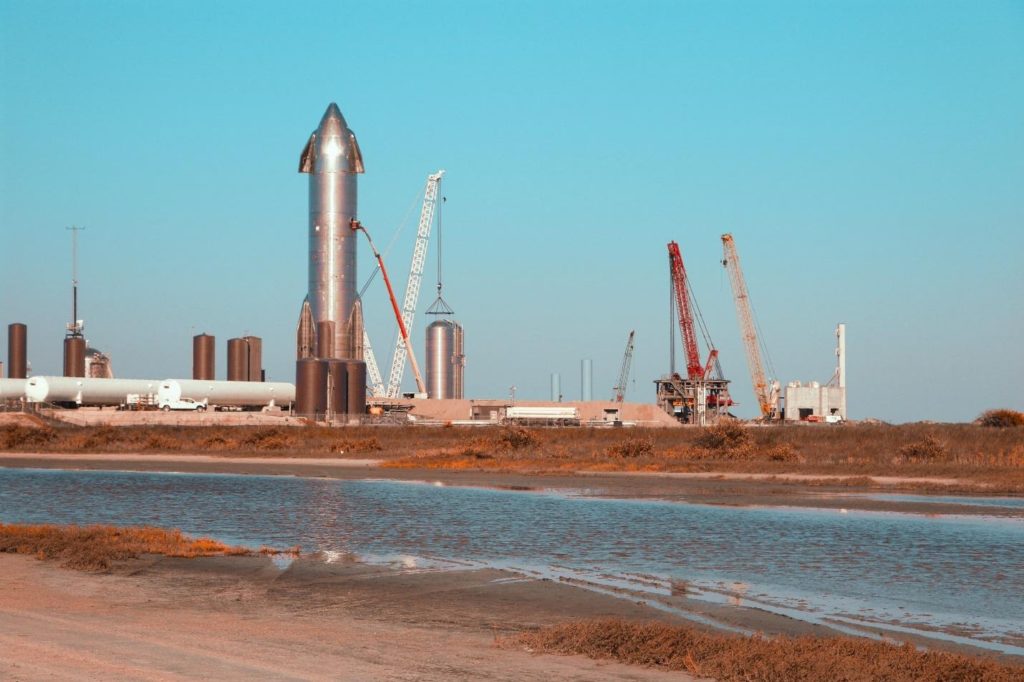
Luis Martinez Santillano/The Rider Photos
Alejandra Yañez | THE RIDER
Federal and state environmental agencies posed questions in comments to the U.S. Army Corps of Engineers regarding mitigation for SpaceX’s application to modify its permit and expand its facilities at the SpaceX South Texas launch site.
The comment period for the corps public notice ended last Tuesday.
A March 4 notice states that SpaceX has proposed to modify the existing permit for the continued development of the “vertical launch area with the expansion and addition of test, orbital, and landing pads, integration towers, associated infrastructure, stormwater management features and vehicle parking.”
The proposed expansion will impact 10.94 acres of mud flats, 5.94 acres of estuarine wetlands and 0.28 acres of nontidal wetlands, according to the corps.
The Rider attempted to contact the corps for comment, but as of press time Friday, it had not received a response.
According to the 2014 environmental impact statement (EIS), SpaceX proposed compensatory mitigation to preserve wetlands at a 10-1 ratio for acreage impacted.
The U.S. Fish and Wildlife Service provided The Rider a copy of the comment letter it sent to the corps, which states it “is unsure if the previous compensatory mitigation for impacts has been satisfactorily completed. This [public notice] indicates that [SpaceX] would mitigate for 17.16 acres of impacts by developing a comprehensive, multifaceted mitigation strategy for the Boca Chica Launch Site.
“[SpaceX] has stated that the information will be updated as the mitigation strategy is finalized. According to Section 404(b)(1) of the Clean Water Act, [SpaceX] must include a mitigation plan with their permit application; however, no mitigation plan was provided for review.”

Luis Martinez Santillano/The Rider Photos
In an email sent to The Rider last Tuesday, Gary Rasp, a media relations specialist for the Texas Commission on Environmental Quality, wrote: “An investigation is currently ongoing regarding SpaceX’s compliance with applicable drinking water and stormwater requirements.”
As of press time Friday, the investigation had not been completed.
The American Bird Conservancy wrote in its comment letter that SpaceX also claims strategies will be taken to avoid and/or minimize impacts to wetlands, according to documents obtained by The Rider.
However the corps public notice states that “it is possible that impacts to wetlands are reduced as the site design is refined.”
In response, the conservancy stated “the public cannot comment on a mitigation strategy that has not been fully developed, finalized or shared with the public.”
The environmental organization also posed the question of when the SpaceX mitigation plan will be available for public comment and if the corps will reopen it for public comment when the plan is available.
“Public lands surround this site and it is imperative to understand what kind of environmental mitigation strategies SpaceX is proposing,” the conservancy letter states.
The “No Net Loss” of wetlands issued by the Environmental Protection Agency (EPA) states its goal is to protect and restore the acres of wetlands impacted to the total acres planned for mitigation in the corps Section 404 permits.
“In other words, if you’re gonna destroy some wetlands you have to make that up in some way, so that in the end, there’s no net loss of wetlands,” said Jim Chapman, president of Friends of the Wildlife Corridor.
Chapman said that due to the potential loss of wetlands, SpaceX will have to make up for the land it will occupy with its proposed new facilities.
“That public notice said nothing about what they were going to do, and so, lots of people and groups and agencies are not happy about that,” he said. “Because how can you comment on their plan if they don’t tell you how they’re going to compensate for that. So, the EPA and [U.S.] Fish and Wildlife Service both made comment letters to that permit application recommending denial of the permit. And that’s actually a pretty big deal.”
The Rider obtained copies of comment letters sent to the corps from the USFWS, Texas Parks and Wildlife, EPA, Surfrider Foundation South Texas Chapter, Defenders of Wildlife Texas and the American Bird Conservancy.
In an email sent to The Rider last Tuesday, Joseph Hubbard, a Region 6 press employee for the EPA, wrote that the agency responded to the corps’ public notice on April 7, stating that as proposed, additional mitigation measures may be required to offset impacts to tidal/mud flats, estuarine wetlands and non-tidal wetlands in the Lower Laguna Madre.
The Rider contacted the SpaceX Media Relations department but was denied an interview. As of press time Friday, the SpaceX point of contact on the corps public notice, Matthew Thompson, had not returned calls for an interview.
Aubry Buzek, a public affairs specialist for USFWS, wrote in an email that the SpaceX facility is adjacent to state-owned lands managed as part of the Service’s South Texas Refuge Complex and to the Lower Rio Grande Valley National Wildlife Refuge (Boca Chica).
“On April 1, the U.S. Fish and Wildlife Service responded to the public notice and recommended denial of the permit as currently written because of the need for a completed mitigation plan and a more thorough analysis of cumulative impacts to wetlands and the listed species that live in this habitat,” Buzek wrote in an email sent to The Rider on Wednesday. “Prior to considering this permit application, the Service requests a revised mitigation plan to address potential pollution and sediment discharges into wetlands and a biological assessment to consider the effects to 11 species listed under the Endangered Species Act.”
The American Bird Conservancy also asked the corps to deny SpaceX’s permit in its present form until a detailed mitigation plan is established.
“It is evident that SpaceX’s mission has changed greatly since the initial Record of Decision in 2014, and this permit request demonstrates only a portion of that overall change,” the conservancy’s letter states. “SpaceX’s history of frequently modifying their permits demonstrates that their mission has changed over time, resulting in cumulative impacts to the habitat and wildlife.”

Luis Martinez Santillano/The Rider Photos
Cameron County Judge Eddie Treviño Jr., who was contacted earlier in the week for an interview, had not responded to The Rider as of press time Friday.
The American Bird Conservancy stated it believes that SpaceX’s activities have destroyed and continue to destroy rare and valuable habitats at Boca Chica that are not found anywhere else in the United States or the world.
“Un-permitted wetland modification actions have already occurred and continue to occur at the SpaceX site,” the conservancy’s letter states. “As we pointed out to the FAA and encourage the Corps to reiterate to the FAA, SpaceX’s new mission and expansion plans require a new [environmental impact statement] to fully evaluate the impacts of their activities on the Boca Chica environment and wildlife.”
Federal agencies prepare an environmental impact statement if a proposed major federal action is determined to significantly affect the quality of the human environment, according to the EPA website. Whereas, an environmental assessment determines whether or not a federal action has the potential to cause significant environmental effects.
The regulatory requirements for an impact statement are also more detailed and rigorous than the requirements for an environmental assessment, according to the EPA website.
The Federal Aviation Agency is in the process of drafting an environmental assessment as stated in its recent Scoping Summary Report for the Draft Environmental Assessment for the SpaceX Starship/Super Heavy Launch Vehicle Program at the SpaceX Boca Chica Launch Site.
The Texas Parks and Wildlife Department also raised concerns about the recent launches at Boca Chica and addressed them in its letter to the corps. Kirk McDonnell, a press office employee for Texas Parks and Wildlife Department, sent a copy of the organization’s comment letter to The Rider last Tuesday.
McDonnell’s email states that the suborbital test flights that resulted in anomalies/explosions, led to debris landing in special aquatic and cultural sites located on TPWD-owned property located north of the project site.
The TPWD letter states that activities associated with the subsequent site investigations and the removal of hazardous and non-hazardous materials and debris have resulted in rutting, trampling and compaction of algal flats and tidal flats as well as rutting and denuding of native coastal prairie and Tamualipan thornscrub communities from the use of all-terrain vehicles, heavy equipment, drag lines and foot traffic.
“Based on these and previous anomalies, fires, and incidents which have occurred as a result of the permitted projects, TPWD has reason to believe that these secondary and cumulative impacts will increase in both frequency and magnitude as a result of the proposed project,” the letter states.
TPWD recommends that the corps and the Texas Commission on Environmental Quality “consider secondary effects of the proposed project on adjacent aquatic resources that would result as a consequence of the proposed action as well as the cumulative effects of past, present and foreseeable future projects in their respective evaluations of the proposed project.”
Rasp, the media relations specialist for Texas Commission on Environmental Quality, wrote in a separate email Tuesday to The Rider that the agency is reviewing the request by SpaceX for a modification of its existing Clean Water Act Section 404 permit.
“TCEQ comments have not been submitted to the U.S. Army Corps of Engineers for this project,” the TCEQ email states.
The Rider received responses from the FAA to questions pertaining to the situation, in which the agency states that SpaceX’s proposal to update its Starship/Super Heavy operations in Boca Chica falls outside the scope of the existing final environmental impact statement and Record of Decision for the launch site.
“Therefore, it requires additional environmental review under the National Environmental Policy Act (NEPA),” an FAA spokesperson wrote in an email sent to The Rider last Tuesday. “The FAA is supervising the preparation of a Draft Environmental Assessment (EA), which SpaceX and cooperating agencies are undertaking. Many of your questions may be addressed in the Draft EA, which will be made available for public review and comment when it is completed.”
As of press time Friday, the FAA had not issued a new environmental assessment.
Asked how the FAA will establish and enforce SpaceX to protect species and habitats in Boca Chica, the FAA spokesperson replied, “The FAA is responsible for ensuring the NEPA process is followed for a project that falls under its authority. The FAA or the cooperating or participating agency with jurisdiction would monitor and enforce any conditions contained in the final environmental document.”





